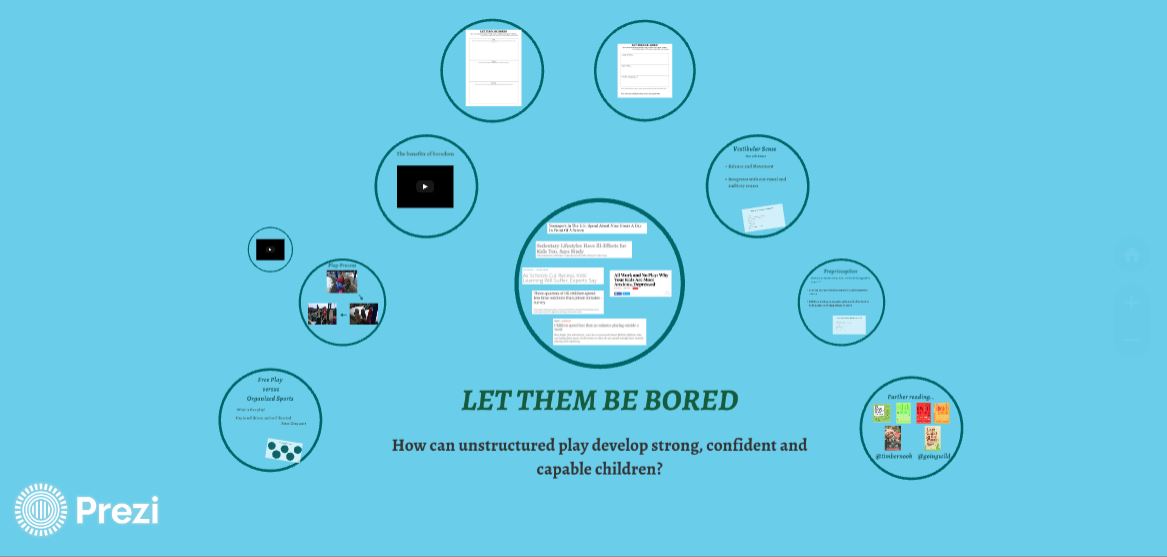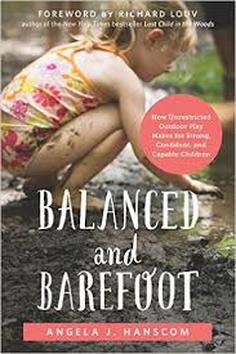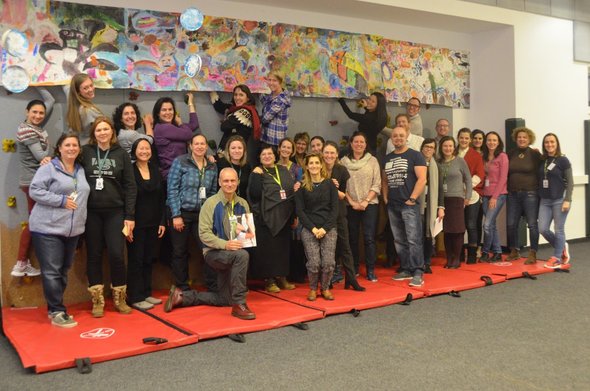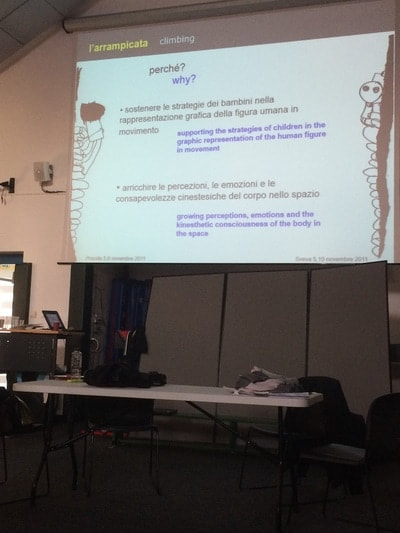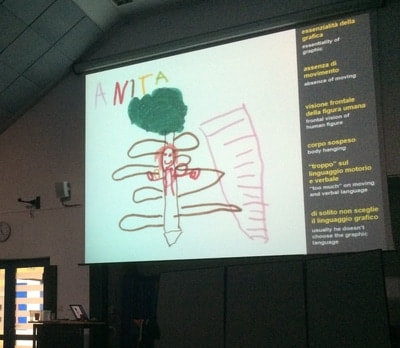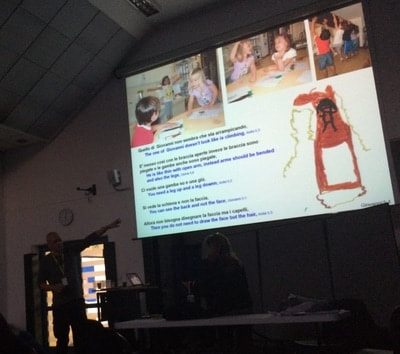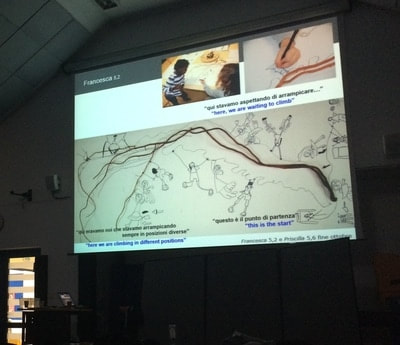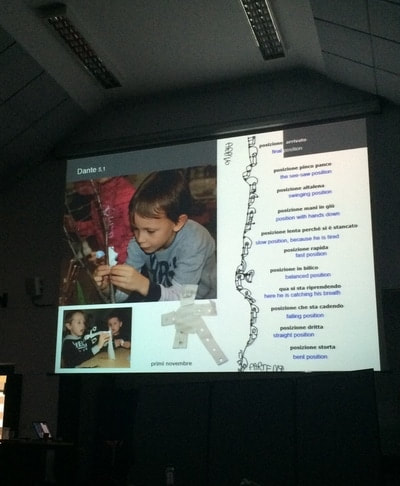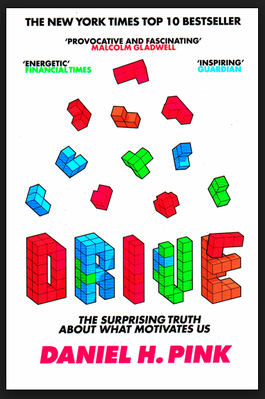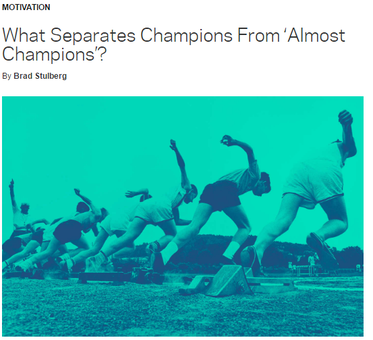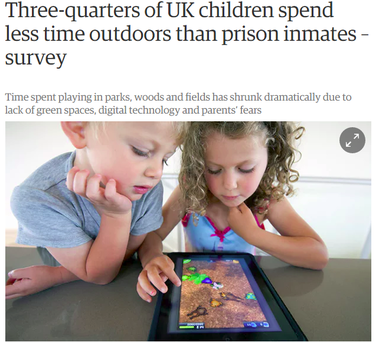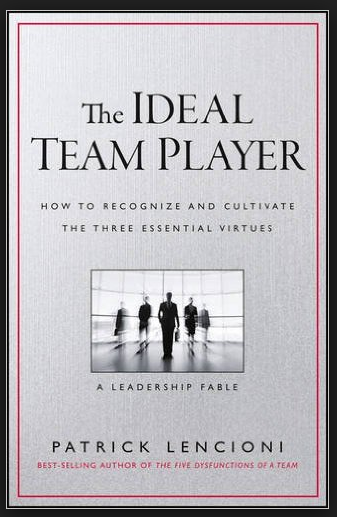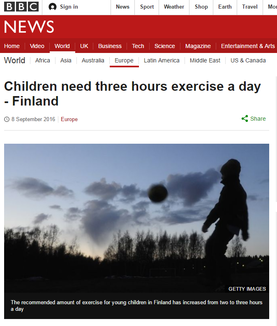|
Our school holds monthly parent coffee mornings, these are to provide a forum for parenthood discussion on a variety of topics deemed important by the parent community or by members of the school faculty. The parents had requested a talk about the benefit of outdoor education, this was one of the reasons why I had read Balanced and Barefoot, as I was to lead this discussion.
When preparing the presentation it developed it's focus from purely being outdoor education, but to also include the concept of free play, which I think is something that is very important for students, but seems somewhat diminishing in comparison to more organized forms of play. To ensure parent engagement and to make them aware of some of the strategies that our students use in their daily lives at AISB, I used two making thinking visible activities Think, Puzzle, Explore and 'I used to think, now I think and I'm still wondering'. These sheets can be found here.
1 Comment
In 2013 the American Academy of Pediatrics released research results indicating the average child spends 8 hours a day in front of a screen (TV, smart phones, video games, computers etc). In the UK 75% of children spend less time outdoors than prison inmates. What are the effects of this sedentary childhood life style, need we be concerned?
Balanced and Barefoot, by Angela Hanscom (founder of Timbernook) highlights how child play has changed over recent decades from playing outside freely with other children in nature or within man made play structures that would be deemed a health and safety (or lawsuit) risk to the sedentary lifestyles of immediate entertainment in a swipe culture of tablets, tvs and video games. Hanscom highlights the effects that we are currently seeing in children with health and cognitive difficulties. Hanscom references a lot of research highlighting the increase of children having difficulty with poor attention skills, controlling emotions, balance, decreased strength and endurance and weakened immune system. Hanscom believes their is a correlation between these and and changes in play among children. To counter act this change in culture Hanscom is not just advocating a more active lifestyle, but more free play (play which is not led by an adult, so football training for a local team does not count). When initiating free play children need to come up with play schemes, present their ideas to others in a way that makes them want to play and once a few children are involved they start to negotiate their play and create a more elaborate form of pretend play. This process of play helps to develop creativity, independence and social skills which help them relate to and understand others. Through regular free play children are able to learn their abilities, likes (and dislikes) how to regulate their emotions and become flexible, resilient and capable. Whilst these skills could be be developed in an adult led activity, the child has a greater sense of ownership and sees that they have been able to cope with these situations helping children become successful wit relationships, school and work experiences in later life. Balanced and Barefoot reads like a manifesto and a manual, using scientific research to highlight issues with child play, whilst also providing a framework for how much play children should have and how to support this. In preparation for the Early Childhood moving into a multi-million euro Reggio Emilia inspired building we were joined by Elena Giacopini and Matteo Bini from Reggio Emilia to further our understanding of the Reggio approach. I was coming into this training with little of what Reggio Emilia looks like and how it would affect my practice. Reggio is an approach and not a method and therefore it is a philosophical framework and does not provide any standards or outcomes. Reggio is an inquiry based approach that recognizes that learning is transdisciplinary, based on the theories of social constructivism, and should be student centered, whilst placing a great importance on the environment. Elena and Matteo constantly provoked and made me question a variety of aspects of how I approach my role in student learning. I do believe that students learn from one another and that they are more engaged when they are not being ‘taught’ at. Upon reflection, there are times when instead of focusing on the students experiences and letting this shape the learning. I sometimes impart my knowledge or funnel students into my way of thinking. Are there times when this is ok? How could some specific skills be taught otherwise? Documentation of students learning is key at Reggio Emilia, this can be seen through the portfolios which are made and follow the students through the school, to how the day is organized and through teacher meetings and discussions. The challenge that I have been contemplating recently is how do we document the process of learning within PE, I have previously recorded a dance routine that students have done at the end of the unit, placed this within student portfolios, but how did they move through the creative process to this end point. Whilst ‘doing’ is a fundamental part of learning, is it enough? Students and teachers must document and reflect throughout the process. One of the key focal points of Reggio Emilia is the 100 languages, which Loris Malguzzi, founder of Reggio Emilia, described as the ‘Infinite ways in which children can express, explore and connect their thoughts, feelings and imaginings.’ The Reggio Emilia approach recognizes and appreciates children as competent and naturally curious learners who can express themselves, and we as teachers need to recognize and document how their learning is developing. Jay McTighe highlights the multi-faceted aspects to learning and how we should consider this when assessing ‘An important concept in assessment lies in our understanding of learning and the learning process and a recognition that learning involves much more than just taking in conversation and giving it back. It involves constructing meaning and making sense of things, seeing things from a different perspective and truly developing an understanding of what students are learning’ so if as an inquiry teacher we are hoping to develop students understanding of key concepts we need to design tasks and ask questions which takes students learning from knowledge to understanding. Here KG students are drawing themselves after climbing a tree, self and peer assessing work. Students talk about body positions/movements/key features whilst considering point of view and use of different materials. Whilst I regularly observe, question and provoke during PE lessons, how do I document this with each child? Making thinking visible routines having proved extremely useful, but this is only one ‘language’. How often should I conference with students? How is this information stored and shared with other teachers and can other teachers comment on what they have seen? How do I document children reflecting on the process, as this constitutes learning. These will be the questions I will be taking forward, documentation should show the process of student learning, showing both the student and the teacher how their learning developed.
This video highlights 5 traits that Tiffany Shlain believes are at the core to being successful in today's world and in watching it I agreed with her, whilst watching this I was thinking how does this relate to PE and the curriculum that we deliver to our students.
Curiosity As an inquiry teacher we should be creating an environment that encourages questions and enables students to explore these 'wonderings' which can lead to even more questions. An example of how we have encouraged this in PE, is through the use of our 'Wonderwall' where students are able to post questions, or wonderings they have related to their unit, or broader concepts. Due to increased PE time in our schedule, we have also been able to give students time at the start of lessons to play with equipment, observe one another or to improve upon areas that they want to work upon. I also think that this ties in with how autonomy can motivate humans, as highlighted by Daniel Pink in Drive, for more on this look at my book review. Creativity Creativity has always been a bit of a dark cloud over me, and that may be because of my archaic interpretation of 'creativity'. Creativity is not just art based or does not even need to be a fresh, original idea. Creativity can be about evolving an idea of someone else to make it more appropriate to your needs or drawing connections from experiences that others may not. This may be as simple as asking students during an adventure challenge activity, to stop and make a connection where they have had to demonstrate similar thinking, skills or collaboration. Initiative Prior to taking initiative students need to be aware of a change or development in their thinking this could be done through a visible thinking strategy such as connect, extend, challenge or I used to think, now i think. From this students will make a decision, whether or not to take action, if they do teachers will need to support and model this process. Who would be a good person in the school or community to talk about this idea with? Or even from another from another country, would that change their perspective? A scaffolded plan and then gradually helping the students gain more independence with their ideas till they are taking their own initiative . Multi disciplinary thinking Instead of looking at PE as a singular subject where students repeat skill drills , how can we make connections with what we are doing in the classroom to our outside lives. Whether we look at cultural dances and their significance during our Movement Composition unit and how these movements express emotions, feelings and traditions. Or looking at the broader concepts of relationships, resilience, fairness and emotions. Empathy Whenever I think of empathy I think of this cartoon of a talk by Brene Brown. Empathy is being aware and sensitive towards how another person is feeling, and the PE environment provides regular teaching moments to discuss empathy. I previously blogged about our Conflict Corner, which has been a big success and it became evident that a lot of conflict between students was simply through not understanding how another person is feeling, or the reasons why they are feeling that way. In some respect children, when given the tools to do this are better than adults at this as children are less judgmental than adults (point proven with my judgment right there!) . Once they share how they are feeling, the other child recognizes this and understands or relates to the feeling, whether it is frustration and not knowing what they are suppose to be doing or feeling lonely as they are not being made to feel part of a team. Starting at AISB in 2013 it was my first position in a PYP school, or where I was first able to gain experience (to put on my CV) that showed inquiry teaching. Initially, coming into the PYP I felt overwhelmed by, what looking back I consider to be, unnecessary buzzwords or lingo linked to the PYP without a clear understanding on how the hip lingo would transfer to a classroom, or more specifically the gym.
As I have continued my development as a PE teacher at AISB, I have come to the understanding that inquiry is not a specific philosophy solely of the IB, it's just good practice. Creating an environment where students draw and make connections with their prior learning, whilst being given a voice to make real choices about their learning are, I believe, the foundations for inquiry. Learning is a two way process both for myself as the teacher and the students, through collaboration and cooperation students are able to enhance their capable, creative and curious minds; we learn from and with others. As inquiry driven teachers we have a responsibility to promote a growth mindset, setting challenging work and ensuring that in the face of adversity, they are able to persist, question, reflect and learn from their mistakes. I am in my 8th year teaching PE and my fourth as a PYP PE teacher, yet I continually feel like I am scratching at the surface in trying to ensure I have a maximal impact upon my students lives... and this excites me! I only hope that my students will enjoy to continuing to scratch the surface! Daniel Pink gave this twitter sized summary at the end of his thought provoking 2009 book Drive: The Surprising Truth About What Motivates Us. The book focuses upon our developing understanding of motivation and how current practices are ‘outdated, unexamined and rooted more in folklore than in science.’ Pink highlights that human motivation has evolved from primitive forms (survival) to carrot and stick and now to what Pink calls, ‘Type I’, or Type Intrinsic.
Without spending too much time on Carrot and Stick, Pink provides numerous research based examples that highlight the archaic carrot and stick method of motivation, or extrinsic rewards such as bonuses and trophies, method can in the long run have a negative effect on not only motivation, but also creativity. Pink puts forward his research backed alternative, the ‘Type I’ drive stating that ‘human beings have an innate inner drive to be autonomous, self determined and connected to one another. And when that drive is liberated people achieve more and live richer lives.’ Type I is dependent upon 3 ingredients; autonomy, mastery and purpose. It is from now, in this blog post and beyond that I will have to consider how this will impact, among other aspects, what I plan and deliver at school. Autonomy ‘Autonomous motivation involves behaving with a full sense of volition and choice’ – Deci and Ryan 2008 Pink goes on to explain that autonomy is different from independence and it means ‘acting with choice – we can be both autonomous and happily interdependent with others.’ Pink also highlights several behavioral science studies that show ‘autonomous motivation promotes greater conceptual understanding, better grades and enhanced persistence in school and sporting activities.’ The PYP gym at AISB is placed between our Early Childhood classrooms and Elementary school. When starting my professional development program at the end of the last academic year, (one of my goals is creating an environment that supports self directed learning, or autonomy among my students in PE) I started to observe some of the Early Childhood classrooms and I noticed a disconnect between what was happening in EC, students moving freely around different stations working on specific tasks at their own pace to a more structured environment within ES. Is this because of the expectations of the curriculum? Are parents and leaders within the schools different? Perhaps it is a reflection of how us, as teachers, ‘manage’ classes to coerce, control or direct learning? Working within the PYP, an inquiry based curriculum, lends itself to student autonomy well. After initial conversations with fellow PYP PE teachers at AISB, our conceptually driven PE curriculum can also support this. At the end of last year, following on from what I had observed in EC and from a key note speech from Andy Vasily at the ECIS PE conference, during a net/wall games unit we gave students the choice to choose between activities that they’d want to participate in for example Tennis, Table Tennis or Badminton (we are supported in doing this as our timetable enables team teaching). I have tried to take this further, this year allowing students the first 15 minutes of a 80 minute lesson to work on skills that they themselves believe they need to improve. Students can choose who they work with, activity ideas with QR codes support and teachers as needed. Students are accountable for their own learning, which can be shared with the class, the teacher, through an exit ticket or through them developing further questions after the session. Mastery Pink defines mastery as the desire to get better and better at something and as autonomy leads to engagement, this is a natural progression. Pink highlights the work of Csikszentmihalyi, who wrote ‘Flow: The Psychology of Optimal Experience’, which has now been added to my list of books to read. Flow is described as the optimal, most satisfying experiences and for Flow to be effective Csikszentmihalyi states that there must be set structure to the activity. There must be: ● a clear goal ● immediate feedback ● challenge well matched to ability When designing activities for students, teachers should have them aligned to the learning objective and ensure that they are differentiated to match the class's varying needs of students' abilities; also considering the speeds at which students work or develop can be irregular and unpredictable. The focus upon this stage, for me at least, is immediate feedback. Dylan William talks about the importance of formative assessment and it being the ‘bridge of teaching and learning’ and the differing types of feedback (ego involving or task involving ) and how these affect learning. These videos were shared during a PYP faculty meeting last year. I have thus been critically reflective upon the feedback I give as I try to ensure feedback is improvement based; leading students to think about the activity and where they are in their own learning (self-assessment) and how they need to do to improve, leading to purposeful practice. Feedback can also be more powerful when received from a peer, benefiting the person receiving the feedback and also the person giving the feedback, as they need to think through what the success criteria is for an activity and what they need to do to get there. This is something that I have become more aware of when planning learning engagements. Enabling students to become student teachers enables the idea of ‘immediate feedback’ to be a realistic expectation when leading activities or during self-directed/ autonomous learning time. Purpose The final stage of the Type I drive is ‘purpose’, which provides the context for autonomy and mastery. The purpose or role of PE within a school curriculum is widely discussed, particularly by people whose experiences of PE were similar to those shown in the movie, Kes. (Even just look at the description of the video ‘a poignant snapshot of all those PE teachers we had’) PE was perhaps seen as an accessory to the school day, a side note to where the learning took place, in the classroom. Through research, a change of focus and more recently social networks ( most noticeably #physed on twitter), PE teachers are sharing good practice, making PE a relevant component of 21st century education, with a focus upon developing social and emotional skills as opposed to just physical, game specific skills. A PE program ensuring ‘Physical Literacy’ is an outcome and students are able to go beyond school and participate to help others lead active and healthy lifestyles; this must be an aim shared and made explicit with students so PE is relevant to the students and education going forward. This was the question asked by Brad Stulberb in a very interesting article that uses sport as it's focus though can be applied to other areas of life and society including education. The article references a case study in the journal Frontiers in Psychology, which looks at 'Super Champions' or world class athletes and 'Almost Champions' athletes who had performed well at youth level, but were now performing in lower leagues now they are adults.
Reading this article brings me back to Carol Dweck's work on Mindset, particularly where Brad Stulberg states 'super champions were characterized by an almost fanatical reaction to challenge.” They viewed challenges in a positive light — as opportunities to grow...' and later Stulberg highlights a difference between Super and Almost Champions in their goal focus; self improvement, comparing themselves to prior versions of themselves for our Super Champions, where our Almost Champions had a focus upon external benchmarks like rankings and comparisons to rivals, which affects motivation during dips in form. A closing statement of the article, referencing previous research, that talented athletes (for this you could also read learners/educators/business leaders) can often benefit from a variety of challenges, which then builds resilience and mental toughness and aides to develop performance to a top level. I have just returned from a MS Girls Soccer team building weekend, which was fantastic. These are 15 of the most active female students from our Middle School. The weekend in Curtea De Arges, a picturesque area of Muntenia, Romania, consisted of three 2 and a half hour training sessions and a hike and even with this select group of competitive athletes I had a conversation about the amount of screen time that students had/wanted. The photo below was taken on a boat ride just before our hike. I shared an article on 10th September on this very subject. Yet it is becoming more apparent, that active play is not happening as frequently in the face of a competition with ipads and other technologies competing for the attention of students in the 21st Century.
A challenge for parents and teachers alike is to encourage students to go outside and away from these screens. The benefits can be wider reaching than just the obvious physical and health benefits. A 2009 study in the Journal of School Health, found that the more physical activity that children undertake, the more likely they are to succeed in academic tests. Another study, this time led by the University of Essex highlights that just five minutes of 'green exercise' can have rapid improvements in mental well being and self esteem. Patrick Lencioni, also the author of '5 Dysfunctions of a Team', believes he knows. Whilst he uses a fictitious case study of a business to highlight the 3 key traits of the ideal team player, he applies his theory in a variety of situations which can be as applicable for myself, as a member of the American International School of Bucharest community, as it could be to helping students understand how to cooperate together effectively.
The ability to work together as part of a team is a necessary skill, which can be applied to almost all aspects of our daily lives. Lencioni highlights three character traits that form the ideal team player; Humility, Hunger & Smarts. Whilst this may seem three obvious and straight forward traits, as we look at how they interact they can become more complex. Lencioni is ready to highlight that ideal, does not mean perfect. Everyone has the ability to improve in one or more trait. Humility Lencioni believes that humility is 'the single, greatest and most indispensable attribute of being a team player. Humble members of the team emphasize the team over themselves, share credit of any successes and define success collectively instead of focusing upon their contribution. They lack excessive ego, or concerns about how others perceive them. "Humility isn't thinking less of yourself, but thinking of yourself less" C.S. Lewis Hunger Hungry members of a team are self motivated, conscientious and will look to take on more responsibility within the team, but in a humble manner. Smart Lencioni describes this as being 'people smart', to demonstrate good inter personal skills, including listening, asking questions and engaging within the group dynamics with an understanding of how words and actions can impact upon others. The book is clearly aimed at adults, and it gives practical advice on how to work with people who want to develop in one or more of these areas. Individually these three traits are obvious and Lencioni agrees, however he believes with just the absence of one it can make teamwork significantly more difficult. A focus for the AISB PE department is working on sportsmanship displayed by our students, and throughout the book I was thinking how this could be applied to benefit our students. PE provides various opportunities to specifically look, try and reflect upon teamwork with our students and this is the main focus of our Adventure Challenge unit. In October we will be starting this unit with our Grade 3 students, and I plan to use these three traits as a central theme of the unit and the basis of students self and peer reflection. I will post an update of how this looks when the unit is underway. Do you agree with the emphasis placed upon these traits? Would you add or take away any? How would you use this to help develop teamwork skills among your students? Finland, and its highly regarded education system, is now recommending that its children participate in physical activity for 3 hours per day, reports the BBC. The Finnish Minister of Education believes their is a correlation between their highly regarded and successful education system and how active their students are.
The benefits of outdoor play go beyond physical development. Their is much research to suggest that outdoor play supports children's problem solving skills and nurtures their creativity, whilst also increasing a child's attention span. Having children play outside together, in unstructured play aides the development of social and behavioural skills, as was discussed in my September 7th blog post. |
